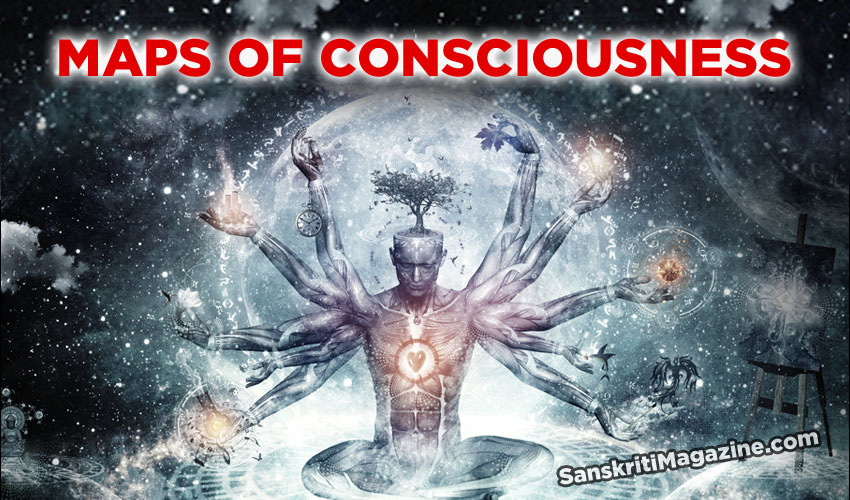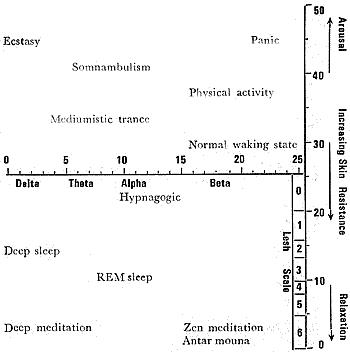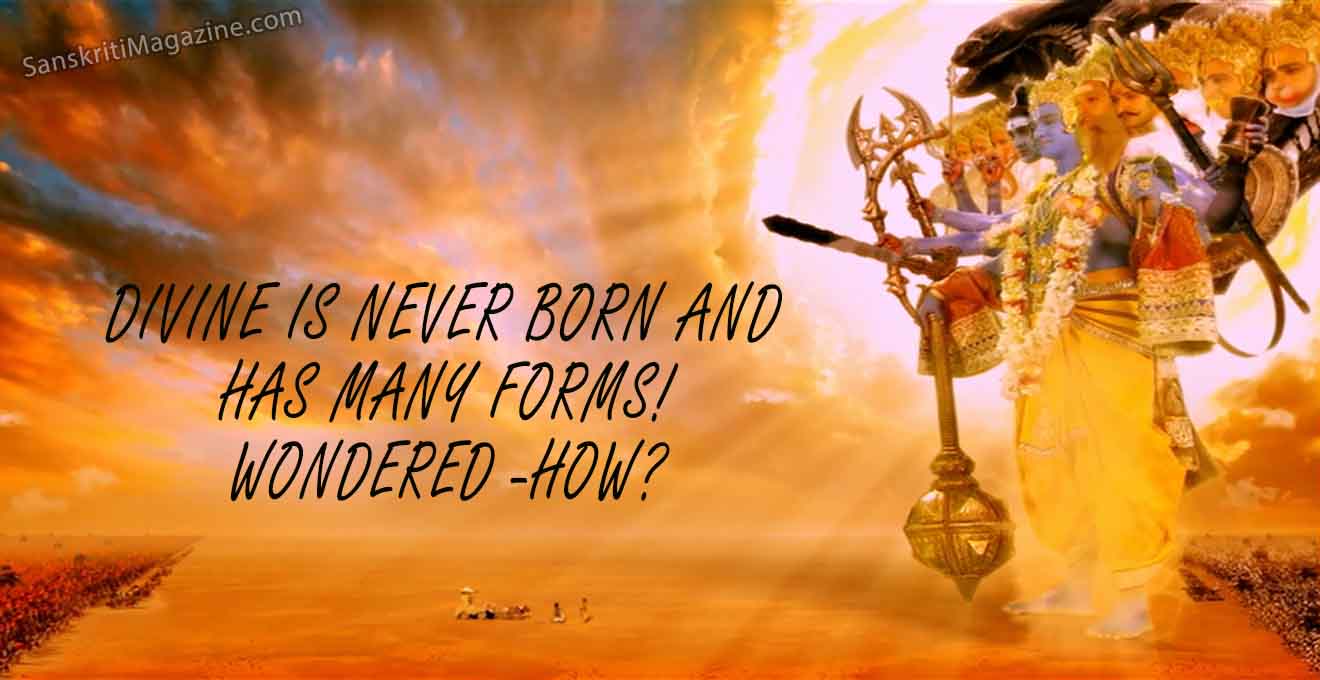Scientific observation of any phenomenon involves the analysis of information from at least one parameter of observation. The more parameters we have for observation, the clearer our picture of the phenomenon will become. For example, if we wish to describe fire only by the sound it makes, our knowledge of fire will be very limited. However, if we also describe the heat, colour, shape and chemical transformations occurring, our understanding of fire will become much more accurate.
In the field of mind research, we have two parameters which can be accurately measured and correlated to give a two dimensional picture of various altered states of consciousness such as meditation, sleep, trance, ecstasy and so on. These two parameters are the autonomic nervous system response and the brainwave frequency.
These two linear parameters may be combined as the horizontal and vertical axes of a graph, and the various correlated states of consciousness mapped onto these axes, as can be seen in Fig. 1 on the following page.
Immediately this picture increases our perception of the various states of sleeping, dreaming, meditation, trance and so on.
The various states shown in the chart were mapped out by G.G. Blundell and C.M. Cade in the books ‘EEG Management’ and ‘Self Awareness and ESR’.
The Lesh scale on the lower vertical axis indicates various subjective sensations described by subjects undergoing deep relaxation. The Lesh numbers 0-5, and the experiences, correlate as follows:
Fig. 1. Correlation of autonomic response and brainwave patterns
The horizontal axis records brainwave frequency in cycles per second, and the vertical axis records autonomic response as measured on an ESR meter as electrode current in micro-amps.
0. Just beginning to relax, may be difficulty in stilling the mind, e.g. ‘Why am I doing this?’
1. Dizziness, foggy consciousness, feeling like going under anaesthetic, unfocused attention, everyday affairs fill the mind.
2. Calmness, feeling of relaxation, past memories recalled.
3. Pleasant bodily sensations of floating, lightness, rocking, swaying. More sustained concentration. Increased and clearer imagery.
4. Vivid awareness of breath, heartbeat, effortless concentration. Feeling of bodily expansion, e.g. being full of air.
5. Very lucid state. Deep, intense alertness, calmness and detachment. Feeling of altered state not present in levels 0-4.
6. New way of feeling. Intuitive insight. Understanding from a new level of awareness. Synthesis of opposites into a higher unity.
Meditation
From Fig. 1 we can see that deep meditation is a combination of both deep relaxation (level 6 on the Lesh scale) and a reduction in brainwave activity. This is a claim borne out by the teachings of yoga. Certainly meditation is more than just relaxation, it is also a process of quietening the mind. The graph also clearly shows that greater levels of physical and mental relaxation are attained during deep meditation than can be achieved during deep sleep.
Sleep
As we begin to fall asleep, we initially move into the hypnagogic state, where we start to relax and alpha waves become predominant. This is the state of quiet reverie, where many images and memories flash before the mind. As we continue to fall asleep we move into the deep sleep zone characterized by delta waves and further relaxation. From here we move into REM (rapid eye movement) sleep which is a deeper state of physical relaxation, but is characterized by higher frequency alpha waves. This is the state of dreaming, when the mind is more active. The process of waking follows the reverse order, from REM sleep to deep sleep through the hypnagogic state to complete wakefulness.
Somnambulism (sleepwalking) can be seen to occur if the mind is in the dreaming state, but the body is aroused. However, this state will only occur when the reticular activating system (RAS) of the brain maintains the body-mind connection during sleep. The function of the RAS will be explained at a later stage.
Daily activity
Our ‘normal’ waking state exists in the midrange of the ESR scale with the brain producing beta waves, indicating thinking, calculating and responding to situations. Increased physical activity is indicated by increasing arousal, and in its extreme form is expressed as panic, where high frequency beta waves and maximum arousal occur.
Antar mouna
The graph also shows that by maintaining a relaxed witnessing attitude of the mind’s activities, we move into the Zen meditative state, the equivalent to the practice of antar mouna. As the various stages in antar mouna are induced, the brainwave frequency decreases until the deep meditation levels are reached.
Ecstasy, mediumistic trance
The states of ecstasy and mediumistic trance are shown by high levels of physical arousal, and low frequency brainwaves, indicating that the person is in touch with the deeper levels of his being, while at the same time being able to move around, talk and so on. We can also see that if we become quiet and relaxed after the ecstatic experience, we can move into the levels of deep meditation. This corresponds to the ‘high’ we feel during practices such as kirtan, where the brainwaves are influenced by the rhythms of the music and mantra, and the body is aroused by singing and clapping. Afterwards we naturally feel deep peace and spontaneous meditation.
Karma yoga and asanas
When karma yoga is performed with complete detachment from our thought processes and expectations of the results, it can be seen to cover a wide range of the graph, leading to meditative experiences, even though there may be a high level of physical activity.
This also explains how the performance of asanas, which by their very nature require physical activity, can lead to ecstatic and meditative states.
RAS – the third dimension?
By correlating levels of autonomic response and brainwave patterns, we already have a clearer picture of the relationship between all the states of consciousness during our waking, sleeping and meditative states. But it must be remembered that these are only two parameters, and the body is a vast complex of systems, each indicating various aspects of the mind and the brain’s activities. With more information we could obtain an even clearer view of the relationship between the states. For example, the graph shows somnambulism to be of a similar nature to ecstasy in that both indicate arousal along with low frequency brainwaves. The difference lies in the level of awareness retained during those states, and the key to these levels of awareness is the reticular activating system (RAS) in the brain.
In simplified terms, the RAS, located in the centre of the brainstem, controls the level of awareness and acts as a type of filter to the information being fed to the brain via the senses. It triggers other areas of the brain into activity and represents the physiological link between body and mind. For example, it isolates the spinal cord during REM sleep to prevent the body from moving around in response to the brain’s activity, i.e. it prevents somnambulism. Every person has his own degree of RAS regulation depending upon the development of his awareness and his conditioning. It is RAS regulation that wakes the mother when the baby cries, while the father sleeps on. It also allows us to concentrate upon something important in the midst of many distracting influences such as noise, bustle and so on, when someone else who is unfamiliar with the situation is easily distracted.
During somnambulism, the body is under the control of the wanderings of the mind. Outside stimuli have little or no effect on the brain. Ecstasy, however, is often a result of external stimulation such as music or a visual object. Ramakrishna was once reported to have gone into ecstasy at the sight of a schoolboy unintentionally standing in a pose resembling Krishna. The activity of the RAS may be the next link in building our ‘map’ into a three dimensional model. By determining the degree to which external stimuli affect the brain, our graph would then have a third axis, and would be more helpful in distinguishing clearly between the various states. The differences between these states still require further investigation and clarification; measurement of RAS activity may be the next step.
~ Swami Tapasmurti Saraswati
The fourth state
The biofeedback results described above are a further indication of the wholeness of the yogic system. This ancient system has been devised to give us a complete experience of body and mind, and eventually beyond both. Our two dimensional graph of modern scientific research is providing us with a map of our experiences which is a useful guide in our voyage through the oceans of the mind. The yogic texts, such as the Yoga Sutras, provide another map of these experiences. They describe four states of consciousness which can be correlated as follows:
1. Jagrat: waking – conscious mind- beta waves
2. Swapna: dreaming – subconscious mind- alpha and theta waves
3. Sushupti: sleeping – unconscious mind- delta waves
4. Turiya: samadhi – super-conscious mind- unknown
The big question now is, what is this turiya state in terms of biofeedback analysis? What combination of brainwave patterns does it represent? Do all brainwaves appear, or do brainwaves appear at all? Is it an experience of the mind, or beyond the mind?
Maybe these questions can never be answered by science. We can only experience it for ourselves. As our guru Swami Satyananda Saraswati has said: “The human being has to develop the higher strata of the mind so that he may be able to comprehend his own completeness, his own perfection, his real identity.”












